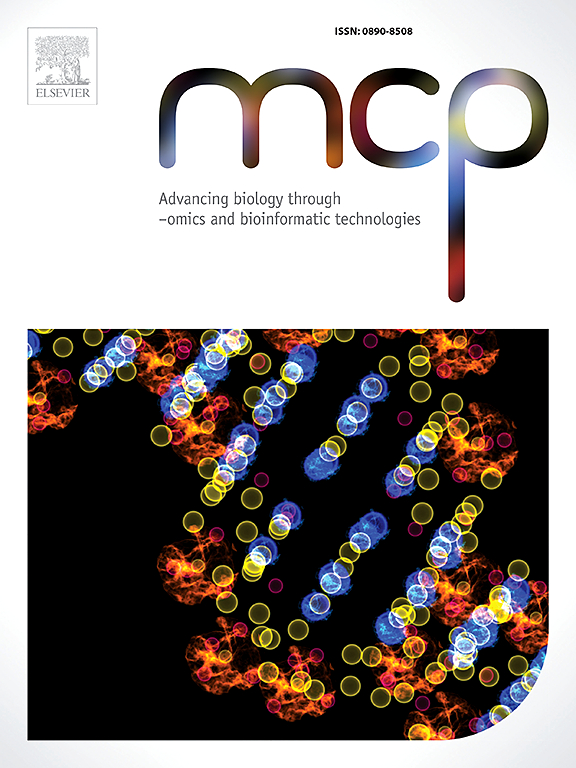lncrna在肺癌亚组中的差异表达。
IF 3
3区 生物学
Q3 BIOCHEMICAL RESEARCH METHODS
引用次数: 0
摘要
目的:长链非编码rna (lncRNAs)已成为肺癌研究中有希望的候选者。本研究旨在评估肺癌组织中与匹配的非肿瘤样本相比,8种自噬相关lncrna的表达,并评估其作为诊断生物标志物的潜力。方法:我们检测了LINC01963、RAB11B-AS1、AC104083.1、PLBD1-AS1、AC005076.1、LOC105376805 (BX284668.5)、AL132989.1和HERPUD2-AS1 (AC018647.2)在非小细胞肺癌(NSCLC)和小细胞肺癌(SCLC)样本中的表达水平,并将其与匹配对照进行比较。根据性别进行亚组分析。结果:与对照组相比,所有8种lncrna在NSCLC样本中均上调,其中AC104083.1和HERPUD2-AS1的平均表达率最高(分别为19.86和14.60)。在男性患者中,所有lncRNAs在肿瘤样本中均显著过表达(p < 0.05),其中AC104083.1上调幅度最大(比值= 26.93)。在女性患者中,虽然观察到上调,但没有lncrna达到统计学意义。在SCLC样本中,大多数lncrna表现出强烈的上调趋势;但p值在0.05 ~ 0.09之间,具有临界显著性。PLBD1-AS1表达差异最大(比值为46.28),LOC105376805表达差异最小(比值为2.16,p = 0.23)。这些lncrna的表达水平可能有助于区分肺癌样本和对照组,并可以区分NSCLC和SCLC样本。结论:这些研究结果表明,所评估的lncrna具有作为诊断性生物标志物的潜力,但需要进一步的研究来证实其实用性。本文章由计算机程序翻译,如有差异,请以英文原文为准。
Differential expression of lncRNAs in lung cancer subgroups
Purpose
Long non-coding RNAs (lncRNAs) have emerged as promising candidates in lung cancer research. This study aimed to assess the expression of eight autophagy-related lncRNAs in lung cancer tissues compared to matched non-tumor samples and to evaluate their potential as diagnostic biomarkers.
Methods
We examined the expression levels of LINC01963, RAB11B-AS1, AC104083.1, PLBD1-AS1, AC005076.1, LOC105376805 (BX284668.5), AL132989.1, and HERPUD2-AS1 (AC018647.2) in lung cancer samples, including non-small cell lung cancer (NSCLC) and small cell lung cancer (SCLC), and compared them to their matched controls. Subgroup analyses were performed based on sex.
Results
All eight lncRNAs were upregulated in NSCLC samples compared with controls, with AC104083.1 and HERPUD2-AS1 showing the highest ratios of mean expression (19.86 and 14.60, respectively). In male patients, all lncRNAs were significantly overexpressed in tumor samples (p < 0.05), with AC104083.1 exhibiting the highest upregulation (ratio = 26.93). In female patients, although upregulation was observed, none of the lncRNAs reached statistical significance. In SCLC samples, most lncRNAs demonstrated strong upregulation trends; however, p-values ranged from 0.05 to 0.09, indicating borderline significance. PLBD1-AS1 showed the highest upregulation (ratio = 46.28), while LOC105376805 had minimal differential expression (ratio = 2.16, p = 0.23). Expression levels of these lncRNAs may help discriminate lung cancer samples from controls and could differentiate NSCLC from SCLC samples.
Conclusion
These findings suggest that the evaluated lncRNAs have potential as diagnostic biomarkers, but further research is needed to confirm their utility.
求助全文
通过发布文献求助,成功后即可免费获取论文全文。
去求助
来源期刊

Molecular and Cellular Probes
生物-生化研究方法
CiteScore
6.80
自引率
0.00%
发文量
52
审稿时长
16 days
期刊介绍:
MCP - Advancing biology through–omics and bioinformatic technologies wants to capture outcomes from the current revolution in molecular technologies and sciences. The journal has broadened its scope and embraces any high quality research papers, reviews and opinions in areas including, but not limited to, molecular biology, cell biology, biochemistry, immunology, physiology, epidemiology, ecology, virology, microbiology, parasitology, genetics, evolutionary biology, genomics (including metagenomics), bioinformatics, proteomics, metabolomics, glycomics, and lipidomics. Submissions with a technology-driven focus on understanding normal biological or disease processes as well as conceptual advances and paradigm shifts are particularly encouraged. The Editors welcome fundamental or applied research areas; pre-submission enquiries about advanced draft manuscripts are welcomed. Top quality research and manuscripts will be fast-tracked.
 求助内容:
求助内容: 应助结果提醒方式:
应助结果提醒方式:


